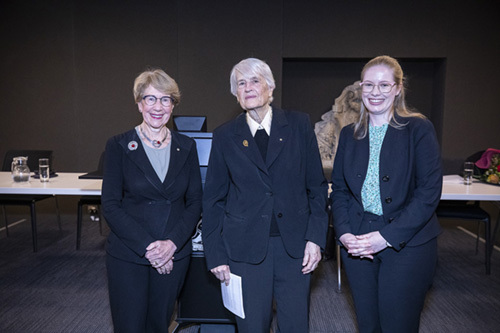- Autumn 2023
- The Honourable Elizabeth Evatt AC’s Contribution to Family Law Delivered by Nicola Gollan 9 November 2022
The Honourable Elizabeth Evatt AC’s Contribution to Family Law Delivered by Nicola Gollan 9 November 2022

This lecture focuses on the profound contribution which the Hon Elizabeth Evatt AC made to family law in Australia, in particular through her role as the first Chief Justice of the Family Court of Australia.
The Family Court of Australia was established as part of the introduction of the Family Law Act 1975 (Cth). The key change to the law implemented by the Family Law Act was the abolition of fault-based divorce. Prior to the introduction of the Family Law Act, the Matrimonial Causes Act 1959 (Cth) stipulated numerous fault-based grounds for divorce, including adultery, desertion, cruelty, habitual alcohol or drug problems, frequent convictions for crime or being convicted of attempted murder.

While separation was a ground for divorce under the Matrimonial Causes Act, the Act required that the parties to the marriage had to be separated for not less than five years. Given the nature of the grounds upon which a person could seek a divorce, court proceedings related to divorce were hardfought and had a huge and often devasting impact on the people involved. Divorce cases were at the time also heavily publicised in many newspapers. Given the nature of the fault-based grounds for divorce under the Matrimonial Causes Act, evidence of highly personal aspects of an individual’s private life was often led, and often then published in gossip columns. This served to heighten the trauma of seeking a divorce under the old Act. Reform to the law regarding divorce and custody of children was included in the Whitlam Government’s platform for election in 1969, and a key proponent of the reforms was Lionel Murphy, who acted as the Attorney General in Whitlam’s government. In support of the reforms Murphy said that:1
The law is largely back where it was in the 19th century. It has been alleviated only by the common sense of judges and practitioners who have been coping with outdated creaking machinery … Money which now goes to divorce costs should go to children of broken marriages. Our divorce laws have become a sick joke which few people any longer find funny.
After a consultation by the Senate Standing Committee on Constitutional and Legal Affairs, the new regime put forward under the Family Law Bill was that there should be a single ground for divorce, being twelve months’ separation. This is now commonly referred to as no-fault divorce, as the establishment of the ground for divorce depends only upon proof of 12 months’ separation. While other jurisdictions were introducing the concept of a no-fault divorce around the same time as the Family Law Act was introduced in Australia, one unique aspect of the Act was its creation of the specialist Family Court, which had a number of significant features tailored to the administration of the new Act. For example, in determining what was in the best interests of the child, the legislation provided for experts to be engaged as part of the new Family Court, to act as counsellors in respect of custody and maintenance issues.
The Hon Elizabeth Evatt AC was appointed by Gough Whitlam as the first Chief Justice of the Family Court. The enormity of the challenge her Honour faced in leading a new and revolutionary court at a time of great societal change is aptly summarised in her own words as follows:2
I accepted the opportunity to apply social idealism to family breakdown – to encourage the spirit of reconciliation, to believe that parents would, if given the chance, put their children’s interest above their own. The Law … would have a new purpose, that of applying principles of fairness and justice to people undergoing the misfortune of a broken marriage. The message may take a long time to learn, but if it can be learned, then perhaps it can be transferred into other areas of human conflict.
In acting as the new Chief Justice of the Family Court, Elizabeth Evatt was faced with the enormous challenge of not only applying the new regime of the Family Law Act, but also of leading the new Family Court which itself had been given a mandate to function in a new and revolutionary manner, as compared with the existing courts within the Australian judicial system.
In recommending the establishment of a new Family Court, the Senate Standing Committee on Constitutional and Legal Affairs outlined the aims of the new specialist court, and the attributes which it was hoped that judges of the Family Court would have, as follows:3
It is of the essence of our recommendation that the judges appointed to this court (men and women) should be chosen for their experience and understanding of family problems and should be drawn from existing judges, members of the bar and solicitors, according to their particular suitability. They would need to recognise their responsibility in developing a new type of court, acting with a minimum of formality, coordinating the work of ancillary specialists attached to the court, encouraging conciliation and applying, only as a last resort, the judicial powers of the court.
A significant way in which the Hon Elizabeth Evatt AC led the judges of the newly established Family Court of Australia was through her approach to ‘compassionate’ judgment writing, which she explained as follows:4
My view was that the decision needed to be written in a way that both sides would consider that they had been fairly dealt with, even if the answer was not what one or other wanted. This meant that you had to try and understand where each party was coming from, what was important to him or her.
This approach was reflected in one of her Honour’s first judgments in the Family Court, where she wrote:5
This is a very sad case. I have to be satisfied on material put before me that the parties have lived separately and apart for 12 months. …Marriage comes in many shapes and sizes and many families are living in a strained relationship like this. To the outside observer, matters go on much as usual, and only within the family itself – between the husband and wife – is there an acknowledgement of the breach. To comply with the Act there must be some overt separation, some evidence that there are two households, not one; it is not established in this case.
When I read this judgment, which was published in the first year of the operation of the Family Court, it reinforced the deeply emotional and personal subject matter that the judges of the Family Court were faced with on a day-to-day basis. The difficulty in deciding these cases must have been compounded by the fact that given the seismic shift in the law which occurred by the introduction of the Family Law Act, the judges were operating in a sphere which had little to no precedent to guide them during the early years of the Family Court.
Adding to the magnitude of the task was the sheer volume of cases which came before the Family Court in its first years of operation. Given the enormous case load, it must have been an incredibly daunting task for the Hon Elizabeth Evatt AC to take on the role of the Chief Justice of the new Family Court. In an article describing the establishment of the Family Court, Justice John Fogarty AM (one of the original judges of the Court) explained that upon opening, the Family Court had what he described as ‘the near fatal problem of the almost en masse transfer of proceedings still pending in the State Supreme Courts’ as many people preferred to have their claims adjudicated under the new Family Law Act.6 There was also a significant increase in the number of applications for divorce under the new Family Law Act, which Justice Fogarty explained increased from 28,383 in 1975 to 66,098 one year later in 1976.7
While the challenge of managing such a large docket of cases may have been anticipated by the Hon Elizabeth Evatt AC, one aspect of the early years of the Family Court that could not have been predicted was the unprecedented, violent attacks which were directed at the staff of the Family Court, including judges and registry staff. During the 1980s, repeated bomb threats and threats of violence towards the staff of the Family Court regularly interrupted court proceedings. Even more shockingly, in 1980, Justice David Opas was shot at his home, and in 1984 Justice Richard Gee’s house was bombed, only a few months before the Paramatta registry of the Family Court was also bombed.8 Later in 1984, Pearl Watson, the wife of Family Court judge, Justice Watson, was killed in a further bomb attack.9
In July 2020, over three decades after these terrible events, Justice Garling of the Supreme Court found Leonard Warwick guilty of the murders of Justice David Opas and Pearl Watson. In delivering his judgment, Justice Garling described the attacks on the Family Court during the 1980s as ‘episodes of extreme violence’, explaining that:10
This was a distinct period of violent offending against judicial officers of the same registry of the same court, in a way not seen before in any court in Australia, let alone concentrated in one registry of an Australian court.
Leading the Family Court through these years demonstrates an enormous amount of courage and commitment to the judicial system on the part of the Hon Elizabeth Evatt AC, and her response to those acts has been remembered as central to the Family Court continuing to operate through exceptionally difficult times.
It has been a great privilege to learn about the Hon Elizabeth Evatt AC’s remarkable contribution to family law in Australia, and her pioneering work as the first Chief Justice of the Family Court of Australia, in preparation for the Sybil Morrison lecture this year. History shows the enormous challenges that she faced, and the amazing courage which she displayed in grappling with each of those challenges. Shurlee Swain has observed that ‘arguably, the Family Court impacts on a larger proportion of the Australian population than any other jurisdiction’.11 This further underscores the profound impact that the Hon Elizabeth Evatt AC’s work in the formative years of the Family Court has undoubtedly had on Australian society, and will no doubt continue to have for many years to come. BN
ENDNOTES
1 S Swain, Born in Hope: the early years of the Family Court in Australia (2012, UNSW Press), p 14.
2 The Hon Elizabeth Evatt AC, The Encyclopedia of Women & Leadership in the Twentieth-Century Australia (https://www.womenaustralia.info/leaders/biogs/WLE0356b.htm).
3 John Fogarty, ‘Establishment of the Family Court’ (2001) 60 Family Matters 90, 94.
4 H Rhoades, ‘The Family Court of Australia: Examining Australia’s first therapeutic jurisdiction’ (2010) 20 Journal of Judicial Administration 67, 72.
5 In the Marriage of Fenech (1976) 9 ALR 527.
6 John Fogarty, ‘Establishment of the Family Court’ (2001) 60 Family Matters 90, 96.
7 Ibid.
8 S Swain, Born in Hope: the early years of the Family Court in Australia (2012, UNSW Press), p 128.
9 Ibid, p 136.
10 Jamie McKinnel, ‘Leonard Warwick Family Court bomber found guilty of murdering three people in 1980s’, ABC News online (https://www.abc.net.au/news/20...).
11 S Swain, Born in Hope: the early years of the Family Court in Australia (2012, UNSW Press).
